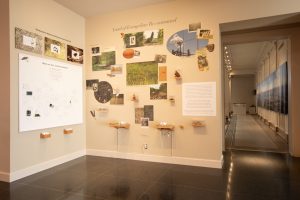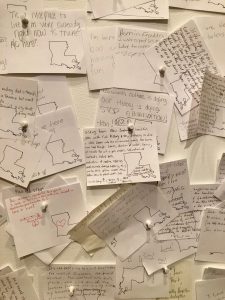
The Land of Evangeline: Reconstructed is an installation by Southerly Gold, an artists collective, on view in the Evelyn L. Burkenroad Creative Concept Studio.
In conjunction with the exhibition Inventing Acadia: Painting and Place in Louisiana, the New Orleans-based artists ensemble known as Southerly Gold was invited to create an installation for the Evelyn L. Burkenroad Creative Concept Studio on NOMA’s first floor. Comprised of three female photographers—Aubrey Edwards, Ariya Martin, and Elena Ricci—Southerly Gold has photo-documented much of Louisiana’s natural and built environments. Their installation, titled Land of Evangeline: Reconstructed, is an amalgam of contemporary and vintage images, found objects, and recordings that immerse viewers in the natural and man-made landscapes of South Louisiana. Evangeline refers to the title character from Henry Wadsworth Longfellow’s epic poem from 1847, Evangeline: A Tale of Acadie, based upon the diaspora of Acadian refugees who settled in Louisiana. The collage is intended to document invasion, extraction, loss, and recovery of the region. Imagery, artifacts, and audio include crawfish mounds, the skull of a nutria, photographs of wetlands and an oil refinery, and recordings of buzzing insects and highway traffic. NOMA visitors are encouraged to interact with the display by offering their own stories related to Louisiana’s ever-evolving landscape on notecards that are mounted to a bulletin board. Responses can also be posted on Instagram or by way of email. A takeaway zine is also available for visitors to keep as a memento.
In addition to this NOMA installation and gallery exhibitions, Southerly Gold has published a collection of books in a project titled God’s Country. A case contains a set of visual field guides to seven of the state’s border parishes: Caddo, Plaquemines, Cameron, and the combinations of East and West Carroll, and East and West Feliciana.
Southerly Gold will speak about their installation during Friday Nights at NOMA on January 24 at 6:30 pm, followed by a book signing of God’s Country in the Museum Shop. The three photographers spoke with NOMA Magazine about Land of Evangeline: Reconstructed as it was being created.
Elena Ricci: When we started working as a group in 2011 we would pursue an umbrella concept. Each of us would go out and shoot our own personal work that was an interpretation of a bigger idea. Then we’d show it together. Our process has evolved since then, and our work is now based on a more collaborative method.
Aubrey Edwards: That’s something process-wise I think is really interesting as far as collaboration goes. It sometimes confuses people when they see our work on the walls. Someone will ask, “Oh, which one is yours?” And I respond, “None of it, and all of it actually.” For many of the images, we compose together, all taking turns adjusting the composition of the image before we make the photograph. These images are taken together. It is a collective eye and a collective ownership of work.
Ariya Martin: We had one show where we handmade all the frames for a large gallery exhibition, which was very taxing. We’ve since shown work in different ways. Over the past year, we started playing around with wallpaper—large-scale images that can go directly onto a wall. For the Creative Concept Studio, we’ll be doing layers of wallpaper, covering an entire wall of different landscapes from Acadiana and South Louisiana.
Aubrey Edwards: We’re revisiting the locations that are shown in the paintings that were created in the 1800s—Algiers, Bayou Plaquemines, Lake Maurepas—and photographing them in present day. We will capture how the landscapes have changed from when they were romanticized in these paintings. Our images will be shown as a wallpaper with accompanying found objects and audio recordings.
Elena Ricci: In creating God’s Country, we came to see that Louisiana varies greatly from north to south, but there are also elements that tie the state together. Boundaries blur and borders are arbitrary. Plaquemines, at the tip of the Mississippi River, has so much water, and efforts at water mitigation, along with oil extraction. Caddo, in the far northern corner, is also shaped by the boom-and-bust cycles of oil. There’s not necessarily a hard delineation between north, south, east, or west in the state.
Ariya Martin: None of us, in our personal work, focus on landscapes. That being said, we each pull our individual backgrounds and expertise as photographers when we document these landscapes. By shooting the land, or the sea, and the evidence of human activity, we’re creating a picture of this place, and how this place has been used over time. Why did people come here? What was the industry? What were the resources that were extracted there? What was the evolving relationship with the people that lived on that land? How can we capture that in imagery?
To learn more about Southerly Gold, visit their website: southerlygold.com. Copies of God’s Country are available for purchase in the Museum Shop.
NOMA members inspire the love of art in every visitor who walks into the Great Hall or through the gates of the Sydney and Walda Besthoff Sculpture Garden.
In addition to enjoying benefits like special members’ previews of exhibitions, free wellness classes surrounded by sculptures, and a complimentary subscription to NOMA Magazine, our members enable schoolchildren to discover the Old Masters, community members to engage with world-class art and local artists, and NOMA’s curators to present innovative and provocative exhibitions year after year.
JOIN TODAY
